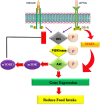Obesity: An Impact with Cardiovascular and Cerebrovascular Diseases
- PMID: 38577137
- PMCID: PMC10987439
- DOI: 10.1007/s12291-023-01157-w
Obesity: An Impact with Cardiovascular and Cerebrovascular Diseases
Abstract
The authors sought to correlate the complex sequel of obesity with various parameters known to develop metabolic syndrome viz. insulin resistance, dyslipidemia, hypertension etc., as these anomalies are linked to vascular atherosclerosis and outbreak of cardiovascular and cerebrovascular diseases. A comprehensive online survey using MEDLINE, Scopus, PubMed and Google Scholar was conducted for relevant journals from 1970 till present time (2023) with key search terms like: 'obesity', 'leptin', type-2 diabetes', 'atherosclerosis', 'cardiovascular and cerebrovascular diseases'. The findings of the reports were compared and correlated. The information was then collated for developing this review. Reports showed that in human obesity, hyper-leptinemia could induce hyperglycemia, which in turn templates hypercholesterolemia. Persisting hypercholesterolemia over a period of time may en-route atherosclerosis in blood vessels. Thus obesity has been considered as a template for originating hyperglycemia, hypercholesterolemia and outbreak of vascular atherogenesis or in other words, obesity in long run can trigger atherosclerosis and its related disorders e.g. heart attack and stroke. Literature survey shows that primarily, co-morbidities of human obesity start with leptin and insulin resistance and then multiplies with metabolic irregularities to an extreme that results in pathogenesis of heart attack and stroke. Atherosclerosis associated cardiovascular and cerebrovascular events are independent risks of obese subjects and particularly in the cases of persisting obesity.
Keywords: Atherosclerosis; Cardiovascular disease; Cerebrovascular disease; Leptin; Obesity; Type-2 diabetes.
© The Author(s), under exclusive licence to Association of Clinical Biochemists of India 2023. Springer Nature or its licensor (e.g. a society or other partner) holds exclusive rights to this article under a publishing agreement with the author(s) or other rightsholder(s); author self-archiving of the accepted manuscript version of this article is solely governed by the terms of such publishing agreement and applicable law.
Conflict of interest statement
Conflict of interestThe authors declare that there is no conflict of interests.
Figures






References
-
- Ramakrishnan G, Beriwal P, Sangam, Chandra NC. Low density lipoproteinemia in obese and type-2 diabetics from association of IR and LDLR. Diabetes Obes Int J. 2019;4(1). 10.23880/doij-16000194.
-
- Suneja S, Ramakrishnan G, Tandon N, Chandra NC. Modulation by insulin of the co-localized LDL receptor in normal and type-I diabetic subjects. Int J Clin Med. 2011;2(3):231–245. doi: 10.4236/ijcm.2011.23038. - DOI
Publication types
LinkOut - more resources
Full Text Sources
Research Materials
